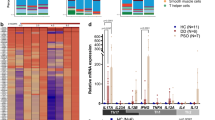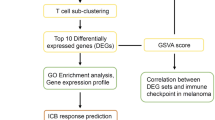Abstract
Alopecia areata (AA) is a common autoimmune disease resulting from damage of the hair follicle by T cells. The immune pathways required for autoreactive T cell activation in AA are not defined limiting clinical development of rational targeted therapies1. Genome-wide association studies (GWAS)2 implicated ligands for the NKG2D receptor (product of the KLRK1 gene) in disease pathogenesis. Here, we show that cytotoxic CD8+NKG2D+ T cells are both necessary and sufficient for the induction of AA in mouse models of disease. Global transcriptional profiling of mouse and human AA skin revealed gene expression signatures indicative of cytotoxic T cell infiltration, an interferon-γ (IFN-γ) response and upregulation of several γ-chain (γc) cytokines known to promote the activation and survival of IFN-γ–producing CD8+NKG2D+ effector T cells. Therapeutically, antibody-mediated blockade of IFN-γ, interleukin-2 (IL-2) or interleukin-15 receptor β (IL-15Rβ) prevented disease development, reducing the accumulation of CD8+NKG2D+ T cells in the skin and the dermal IFN response in a mouse model of AA. Systemically administered pharmacological inhibitors of Janus kinase (JAK) family protein tyrosine kinases, downstream effectors of the IFN-γ and γc cytokine receptors, eliminated the IFN signature and prevented the development of AA, while topical administration promoted hair regrowth and reversed established disease. Notably, three patients treated with oral ruxolitinib, an inhibitor of JAK1 and JAK2, achieved near-complete hair regrowth within 5 months of treatment, suggesting the potential clinical utility of JAK inhibition in human AA.
This is a preview of subscription content, access via your institution
Access options
Subscribe to this journal
Receive 12 print issues and online access
$209.00 per year
only $17.42 per issue
Buy this article
- Purchase on Springer Link
- Instant access to full article PDF
Prices may be subject to local taxes which are calculated during checkout




Similar content being viewed by others
References
Gilhar, A., Etzioni, A. & Paus, R. Alopecia areata. N. Engl. J. Med. 366, 1515–1525 (2012).
Petukhova, L. et al. Genome-wide association study in alopecia areata implicates both innate and adaptive immunity. Nature 466, 113–117 (2010).
Gilhar, A., Ullmann, Y., Berkutzki, T., Assy, B. & Kalish, R.S. Autoimmune hair loss (alopecia areata) transferred by T lymphocytes to human scalp explants on SCID mice. J. Clin. Invest. 101, 62–67 (1998).
McElwee, K.J. et al. Transfer of CD8+ cells induces localized hair loss whereas CD4+/CD25− cells promote systemic alopecia areata and CD4+/CD25+cells blockade disease onset in the C3H/HeJ mouse model. J. Invest. Dermatol. 124, 947–957 (2005).
Ito, T. et al. Maintenance of hair follicle immune privilege is linked to prevention of NK cell attack. J. Invest. Dermatol. 128, 1196–1206 (2008).
Sundberg, J.P., Cordy, W.R. & King, L.E. Jr. Alopecia areata in aging C3H/HeJ mice. J. Invest. Dermatol. 102, 847–856 (1994).
McElwee, K.J., Boggess, D., King, L.E. Jr. & Sundberg, J.P. Experimental induction of alopecia areata-like hair loss in C3H/HeJ mice using full-thickness skin grafts. J. Invest. Dermatol. 111, 797–803 (1998).
Bertolini, M. et al. Abnormal interactions between perifollicular mast cells and CD8+ T cells may contribute to the pathogenesis of alopecia areata. PLoS ONE 9, e94260 (2014).
Best, J.A. et al. Transcriptional insights into the CD8+ T cell response to infection and memory T cell formation. Nat. Immunol. 14, 404–412 (2013).
Bezman, N.A. et al. Molecular definition of the identity and activation of natural killer cells. Nat. Immunol. 13, 1000–1009 (2012).
Brajac, I., Gruber, F., Petrovecki, M. & Malnar-Dragojevic, D. Interleukin-2 receptor α-chain expression in patients with alopecia areata. Acta Dermatovenerol. Croat. ADC 12, 154–156 (2004).
Fehniger, T.A. & Caligiuri, M.A. Interleukin 15: biology and relevance to human disease. Blood 97, 14–32 (2001).
Ye, W., Young, J.D. & Liu, C.C. Interleukin-15 induces the expression of mRNAs of cytolytic mediators and augments cytotoxic activities in primary murine lymphocytes. Cell. Immunol. 174, 54–62 (1996).
Meresse, B. et al. Reprogramming of CTLs into natural killer-like cells in celiac disease. J. Exp. Med. 203, 1343–1355 (2006).
Saikali, P., Antel, J.P., Pittet, C.L., Newcombe, J. & Arbour, N. Contribution of astrocyte-derived IL-15 to CD8 T cell effector functions in multiple sclerosis. J. Immunol. 185, 5693–5703 (2010).
Meresse, B. et al. Coordinated induction by IL15 of a TCR-independent NKG2D signaling pathway converts CTL into lymphokine-activated killer cells in celiac disease. Immunity 21, 357–366 (2004).
Freyschmidt-Paul, P. et al. Interferon-γ-deficient mice are resistant to the development of alopecia areata. Br. J. Dermatol. 155, 515–521 (2006).
Gilhar, A., Kam, Y., Assy, B. & Kalish, R.S. Alopecia areata induced in C3H/HeJ mice by interferon-γ: evidence for loss of immune privilege. J. Invest. Dermatol. 124, 288–289 (2005).
Freyschmidt-Paul, P. et al. Reduced expression of interleukin-2 decreases the frequency of alopecia areata onset in C3H/HeJ mice. J. Invest. Dermatol. 125, 945–951 (2005).
O'Shea, J.J., Kontzias, A., Yamaoka, K., Tanaka, Y. & Laurence, A. Janus kinase inhibitors in autoimmune diseases. Ann. Rheum. Dis. 72 (suppl. 2), ii111–ii115 (2013).
Quintás-Cardama, A. et al. Preclinical characterization of the selective JAK1/2 inhibitor INCB018424: therapeutic implications for the treatment of myeloproliferative neoplasms. Blood 115, 3109–3117 (2010).
Ghoreschi, K. et al. Modulation of innate and adaptive immune responses by tofacitinib (CP-690,550). J. Immunol. 186, 4234–4243 (2011).
Eichler, G.S., Huang, S. & Ingber, D.E. Gene Expression Dynamics Inspector (GEDI): for integrative analysis of expression profiles. Bioinformatics 19, 2321–2322 (2003).
Verstovsek, S. et al. Safety and efficacy of INCB018424, a JAK1 and JAK2 inhibitor, in myelofibrosis. N. Engl. J. Med. 363, 1117–1127 (2010).
Harrison, C. et al. JAK inhibition with ruxolitinib versus best available therapy for myelofibrosis. N. Engl. J. Med. 366, 787–798 (2012).
Punwani, N. et al. Preliminary clinical activity of a topical JAK1/2 inhibitor in the treatment of psoriasis. J. Am. Acad. Dermatol. 67, 658–664 (2012).
Paus, R., Nickoloff, B.J. & Ito, T.A. A 'hairy' privilege. Trends Immunol. 26, 32–40 (2005).
Waldmann, T.A. The biology of interleukin-2 and interleukin-15: implications for cancer therapy and vaccine design. Nat. Rev. Immunol. 6, 595–601 (2006).
Dolgin, E. Companies hope for kinase inhibitor JAKpot. Nat. Rev. Drug Discov. 10, 717–718 (2011).
Acknowledgements
We thank the National Alopecia Areata Registry, as well as M. Duvic, V. Price, M. Hordinsky and D. Norris, and the National Alopecia Areata Foundation. We thank J. Sundberg, T. Behrens, D. Bickers, J. O'Shea, T. Waldmann, B. Jabri, D. Raulet, L. Lanier, T. Spies, M. Hayden, R. Paus, P. Green, B. Lebwohl, D. Accili and C. Jahoda for stimulating discussions. We are grateful for clinical support from M. Furniss, C. Clark and G. Ulerio and expert technical assistance from M. Zhang, E. Chang, H. Lam and J. Huang. This work was supported in part by US Public Health Service National Institutes of Health NIAMS grants R01AR056016 (to A.M.C.) and R21AR061881 (to A.M.C and R.C.), a Shared Instrumentation Grant for the LSR II Flow Cytometer (S10RR027050) to R.C. and the Columbia University Skin Disease Research Center (P30AR044535), as well as the Locks of Love Foundation and the Alopecia Areata Initiative. J.E.C. is supported by the T32GM082271 Medical Genetics Training Grant (issued to A.M.C.). A.J., C.A.H., S.H. and A.d.J. are recipients of Career Development Awards from the Dermatology Foundation, and A.J. is also supported by the Louis V. Gerstner Jr Scholars Program.
Author information
Authors and Affiliations
Contributions
L.X., Z.D. and A.J. were responsible in large part for performing the studies reported herein and participated in the design, execution and interpretation of the data. C.A.H. was responsible for establishing the C3H/HeJ graft model. A.d.J., S.H., G.M.D., L.R. and P.S. were involved in additional molecular and cell biological experiments. W.G. performed immunofluorescence and morphometric studies. L.P. and J.E.C. performed biostatistical analysis of all data sets. J.M.-W. was instrumental in human sample acquisition and analysis. A.M.C. and R.C. were responsible for conception, design, oversight, execution and interpretation of data for this study. All authors contributed to drafts, writing, figure preparation and editing of the final manuscript.
Corresponding authors
Ethics declarations
Competing interests
Columbia University has filed for intellectual property protection on the treatment of AA with small-molecule JAK inhibitors (PCT/US2011/059029 and PCT/US2013/034688).
Supplementary information
Supplementary Text and Figures
Supplementary Figures 1–17, Supplementary Tables 1–5 and Supplementary Methods (PDF 26872 kb)
Rights and permissions
About this article
Cite this article
Xing, L., Dai, Z., Jabbari, A. et al. Alopecia areata is driven by cytotoxic T lymphocytes and is reversed by JAK inhibition. Nat Med 20, 1043–1049 (2014). https://doi.org/10.1038/nm.3645
Received:
Accepted:
Published:
Issue Date:
DOI: https://doi.org/10.1038/nm.3645
This article is cited by
-
Deciphering the molecular mechanisms of stem cell dynamics in hair follicle regeneration
Experimental & Molecular Medicine (2024)
-
Januskinaseinhibitoren
Die Dermatologie (2024)
-
Protein kinases: drug targets for immunological disorders
Nature Reviews Immunology (2023)
-
A virtual memory CD8+ T cell-originated subset causes alopecia areata through innate-like cytotoxicity
Nature Immunology (2023)
-
Alopecia Areata: Current Treatments and New Directions
American Journal of Clinical Dermatology (2023)



